BeoSystem 1200
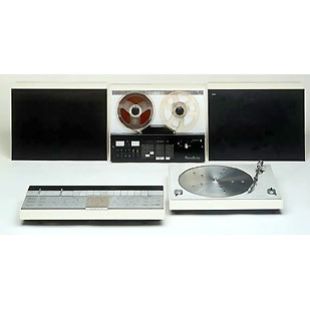

Beosystem 1200 – made up of Beomaster 1200, Beocord 1200 and Beogram 1200 was Bang & Olufsen’s B&O’s first designed system. The design ‘kinship’, which emphasised the interdependence between B&O’s various products, became a characteristic of B&O for many years. Beosystem 1200 was one of the first products selected by New York’s Museum of Modern Art for the museum’s permanent collection (not exhibition) in 1972.
The 1200 series represented the logical continuation of the line of development and design which put B&O at the forefront of manufacturers of entertainment electronics.
In 1969 the Danish Society of Industrial Design awarded Bang & Olufsen and Jacob Jensen the ID prize for the Beomaster 1200 radio/amplifier, Beogram 1200 turntable and Beocord 1200 cassette recorder for unusually beautiful and user friendly design. The jury emphasised in particular the Beomaster 1200 receiver which pointed in a new direction for the design of radios.
| Title | Categories | View |
|---|
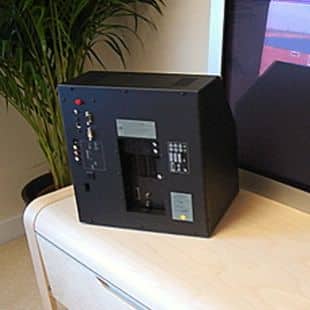
Specifications:
Dimensions W x H x D 325 x 370 x 265 mm
Weight 11,8 kg
Cabinet finish Black
Mains voltage range 220-240V +/- 10%, 50 Hz typical
Power consumption
Terminal included
RGB Out
RS232 Typical:35 W, standby: 1.8 W
Beo4
PAL : RGBHV 575P 50Hz
NTSC : RGBHV 480P 60Hz
For control of BeoVision 4 42
Diagonal picture size
in combination with BeoVision 4 42 42″ / 106cm
Aspect ratio 16:9 (wide-screen)
Picture display formats Format 1: Panorama
Format 2: Letterbox zoom
Format 3: 16:9
Viewing comfort Picture format optimization
Electronic curtain
VisionClear
Teletext
Digital Adaptive Luminance Peaking
Adaptive noise reduction
Vertical peaking
Motion compensated progressive scan
Digital Colour Transient Improvement (CTI)
Adaptive black
Teletext level 2½, 1780 pages
Wide Screen Signalling (WSS)
FastText (FLOF), 4 memory pages per programme
17 Teletext languages in 7 groups
System modulator : Splitter/system modulator output to link room (Beolink Video Distribution)
Frequency range 479 – 831 MHz (in 1 MHz step), Dual side band
Audio Mono
According to type : FM sound system G : 5.5MHz,
FM sound system I : 6MHz
Connection 1 x 75 ohm aerial male
Dolby® Digital Decoder :
Decoding capabilities Dolby® Digital 5.1 channel decoding
Dolby® Pro-Logic decoding of two channel Dolby® Digital
Dolby® Pro-Logic decoding of two channel PCM
Dolby® Pro-Logic decoding of two analogue channels
(Lt/Rt)
DTS®
Automatic format detection (Dolby® Digital, PCM)
Calibration 3 channel tone control & loudness (L/C/R)
Bass management, Delay management
Sound modes (Speaker 1 – 5) Speaker 1 : Stereo Centre speakers (subwoofer muted)
Speaker 2 2.0/2.1 : Stereo front speakers / Stereo
external speakers + subwoofer
Speaker 3 3.0/3.1 : Dolby®-3 stereo / Dolby®-3 stereo + subwoofer
Speaker 4 4.0/4.1 : Stereo-4 / Stereo-4 + subwoofer
Speaker 5 5.0/5.1 : Dolby® Digital or Dolby® Pro-Logic
Surround / Dolby® Digital + subwoofer
Connections :
– Digital audio input
– External Beolab speakers
2 x Coax phono, Input-1 for AV-SCART, Input-2 for DECODER-SCART
6 x Power Link (left, right, rear left, rear right, subwoofer and centre)
Loudspeakers recommended, front/rear Beolab 1, Beolab 8000, Beolab 6000, Beolab 4000, Beolab Penta, II, III, Beolab 4500
Loudspeakers recommended, subwoofer
Loudspeakers recommended, Centre BeoLab 2
2x BeoLab 4000
Set-top Box Controller :
Controlling boxes with Beo4 Supported boxes : See list at Bang & Olufsen
Retail System (via internet)
Controlling one or two boxes (2 x STB) 1 box control by use of the IR-blaster included in the kit.
2 box control by use of the IR-blaster included in the kit
and IR Y-adaptor (6174171) and one more IR-blaster (8330352).
Connection
Accessories:
Product name
Type number
Finish
Dimensions W x H x D/ Weight 1 x stereo mini jack
Cabinet
2168
Black-soft touch
Front panel : Silver
50 x 56 x 40 / 23 kg.
Connections:
TV Input 1 x 75 ohm aerial female
V.TAPE – AV – Decoder 3 x 21-pin sockets
V.TAPE: CVBS in/out, RGB in (automatic 16:9 sense(pin-8), B&O AVL)
AV : CVBS in/out, RGB in, S-VHS in/out (automatic 16:9 sense (pin-8),
automatic S-VHS configuration, B&O AVL)
DECODER : CVBS in/out (automatic 16:9 sense (pin-8))
Beolink 1 x Master Link socket
Camcorder/Auxiliary 3 x Phono sockets (video in/audio L-R in) *)
S-Video (S-VHS) 1 x Y/C playback 4-pin socket
Headphone socket 1 x Mini jack
Dolby® Digital
– External BeoLab speakers
– Digital audio input 6 x Power Link (2 x front, 2 x rear, 1 x subwoofer,1 X center)
2 x Coax phono, Input-1 for AV-scart, Input-2 for DECODER-scart
STB-Controller output 1 x Mini jack (stereo for 2 x IR-blaster with IR-Y-adaptor)
RGB-HV out 1 x 15 pin D-Sub
RS-232 1 x 9 pin D-Sub only for recommended Plasma screen
External IR 1 x Mini jack
External Fan 1 x 5 pin Din ( index no: 8400234 )
System Modulator 1 x 75 ohm aerial male (splitter/system modulator output).
According to type : G or I RF output
*) Possible to configure Set-top box (STB) at Camcorder input and control by STB-Controller
Link compatibility:
Master Link
Optional features/modules:
None
It is not possible to mount internal DVB-S in this product
Market specifications:
Market: Type: Country: Active CTV system Basic CTV system *)
NEU 8491 A-B-D-DK-CH-E-GR-I-N-NL-P-S-SF-EXP-Singapore B/G B/G
HK 8492 Hong Kong M/I/D/K B/G/M/I/D/K/L
GB 8493 UK-EXP I B/G/L/L’/I/D/K
FGB 8494 F-GB-CH B/G/L/L´ (NICAM B/G/L) B/G/L/L’/I/D/K
AUS 8495 AUS, NZ B/G B/G
EEU 8496 East Europe B/G/D/K B/G/M/I/D/K/L
*) Basic CTV systems can be switched ON in Service menu
Available documents are listed, if none are listed then please reach out to see if we have them.
Please let us know
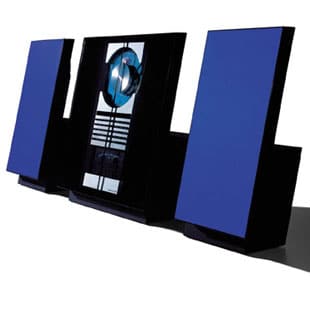
David Lewis’ Beosystem 2500 from 1991 marked a new era of design for hi-fi. In its design, he set out to emphasise the function of the machine. The front is protected by a Perspex eyeshade which slides inwards when in use. Lewis here introduced the flat, standing shape which has come to characterise his Bang & Olufsen designs; for instance BeoSound 9000.
Its interface, designed by Sally Beardleys, is simple and well thought out. Since Beosystem 2500 is very compact it has taken a lot of work to make its small loudspeakers effective and harmonious. Among other things this has been solved by making use of separate power sources to the loudspeakers in order to optimise their sound. The design was followed up by BeoSound Century, which, compared to the 2500 is smaller and cheaper.
Tradition had it that music systems should be recognised at such. However, not so at Bang & Olufsen. In spite of its size, Beosystems 2300 and 2500 featured operation and performance on a level that compared with larger B&O audio systems. And adding to the magic of the fascinating new sound experience at the time of its introduction, was the way that the smoked glass doors slid open the instant the beams are broken by a wave of your hand – revealing the controls beneath.
Beosystem 2300 / 2500 gave you two extremely powerful active loudspeakers – BeoLab 2500 – which acted as completely integrated components in the system. The source selection and programming keys you needed to operate Beosystem 2300 / 2500 were located in a central keypad. And just above them was an illuminated display which could keep you informed of the source and track you were listening to. Every time you touched a key, the display told you exactly which function you activated.
Beocenter 2500, or Beosystem 2500 as it was called when used with BeoLab 2500 active speakers, was developed from the idea of a flexible music system that could compete with the sound quality of heavy music systems. Thanks to the advent of active speakers, this was a possibility with both Beocenter 2500 and its CD-only capable Beocenter 2300. With active speakers, each of the powerful bass and treble units were equipped with their own separate amplifiers. In addition, the electronic cross-over network ensured full bass reproduction.
The loudspeakers were located on both sides of a centre console, where two clear glass covers automatically glided to the side when a hand was passed in front of them. Behind the glass covers there was access to the operating panel, receiver, CD player and a cassette recorder.
The receiver allowed the option of presetting 2 x 20 FM/AM radio stations. The cassette recorder featured Auto Reverse, Automatic Recording level, search function and Bang & Olufsen’s HX-PRO recording system, a system which ensures that the sensitive treble range is captured in recording. The memory in Beocenter 2300’s CD player allowed you to edit up to 100 CDs.
Both systems could be operated via their operating panel or a Beolink 1000 or Beolink 5000 remote control. There were sockets for headphones and connection to additional sound sources; extra loudspeakers can also be connected.
Beocenter 2500 was available with loudspeaker panels in cobalt grey, black, white, cerise or jade. It was later known as BeoSound Ouverture and could be made up to the Beosystem 2500 when incorporated with the BeoLab 2500 active loudspeakers.
This classic design was reincarnated over a 21 year period with various mounts and stands. Floor stands were available with a pole stand or CD and tape storage, wall mount solutions allowed for the Hi-Fi only, or with BeoLab2500 speakers until these were discontinued
Dimensions W x H x D: 83 x 36 x 16 cm
Weight: 20 kg
Black front
98 dB IEC stereo
Active speakers frequency range + 4 – 8 dB 55 – 20,000 Hz
Pre-tuned radio programmes 2 x 20 FM or AM
Tuner range FM 87.5 – 108 MHz
76 – 90 MHz (Japan)
LW 150 – 350 kHz
MW 520 – 1610 kHz
Power consumption/minimum Max. 35 watts/ 4 watts (Beocenter only)
Tape recorder built-in
Recording system HX PRO
Tape transport Auto Reverse
Noise reduction Dolby B NR
Frequency range 30 – 16,000 Hz
Signal-to-noise ratio chrome Dolby B > 65 dB
CD player built-in
Frequency range: 3 – 20,000 Hz +/- 3 dB
Signal-to-noise ratio A-weighted > 110 dB
Converter system: 2 x 16 bit 4 x oversampling
Connections:
Beocord Tape 2 Via Aux socket
Beogram LP (RIAA built-in) Via Aux socket
BeoLab speakers 2 x Power Link
Beovision Via AUX socket
Local rooms, speakers 2 Via MCL 2P
Aux 7-pin socket
Available documents are listed, if none are listed then please reach out to see if we have them.
Please let us know
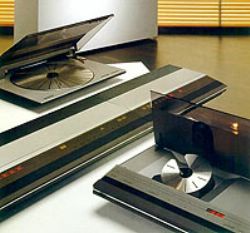
Bang & Olufsen designs are always refreshingly different – a pleasure to look at as well as to hear. Which could be why the company has earned itself over the years coveted places in the Museum of Modern Art in New York.
Beosystem 3300 was the latest addition to a collection which fascinated people from all over the world. You could hang it on the wall among your other works of art; or place it where you like – those sleek, modern shapes would always look good.
But Beosystem 3300 had a great deal more to offer than an ultra-modern appearance. With records, tapes, radio and compact discs it was a top quality music system that really knew how to perform, according to the 1988 catalogue.
The radio-amplifier was the heart of the system, connected by Datalink to the other equipment and passing on the commands you gave via remote control, or by a light touch directly on the panel.
You could preset up to five radio stations. The amplifier had a power output of 2 x 30 watts and a power handling system which prevented overloading and distortion.
Colours: white or metallic grey
You had the benefits of the very latest technology with this tape player. Such as Bang & Olufsen’s patented HX Pro recording system which enriched the sound image by giving vastly superior reproduction of the treble range.
You were certain to approve of the wealth of useful features, too. For example, if the record finished while you were recording, the tape stopped automatically and restarted automatically when you turned the record over.
When you pressed STOP after a recording, a four second pause was inserted between tracks with the automatic search system. Clever stuff – all designed to make life easier and more fun.
Colours: white or metallic grey
It is always better both for your records and for sound quality to play a record the way the master was made – in a straight line from the edge to the centre. This tangential arm record player did just that, giving a far more precise reading of the signals in the groove. The MMC4 cartridge made a vital contribution too; it was a feather-weight, with a stylus pressure of only 1,2 grams, giving outstanding sound quality but minimising wear and tear on your records.
There was more protection too – invaluable for all-night parties. The electronically controlled tangential arm was suspended so that it isolated mechanical vibrations from the cartridge. The suspension chassis was also thoroughly engineered to neutralise vibrations. So you could keep on dancing – the record player could take it!
It’s a fact that not all compact disc players are ideal for all types of music. Some of them seem to highlight certain parts of the frequency range. But you could be confident that Bang & Olufsen’s CD players didn’t discriminate between rock and roll and classical. They smoothed over faults in the CD very cleverly too, because not all compact discs are perfect. So it was just as well that Bang & Olufsen CD players were and still are!
| Title | Categories | View |
|---|
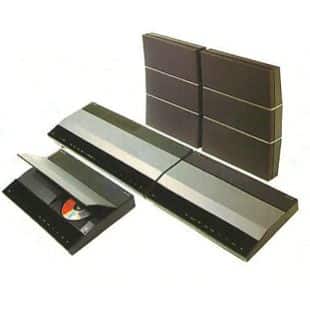
The system’s lines were pure with everything superfluous omitted. It was specially designed to hang either on a wall or sit on a shelf or table. A light touch on its illuminated display gave immediate access to AM/FM receiver, CD player and cassette recorder; all of which were the latest and best in their respective fields. The system was completed by a pair of RedLine RL35 speakers and operated via a Beolink 1000 remote control unit.
| Title | Categories | View |
|---|
Please let us know
Available documents are listed, if none are listed then please reach out to see if we have them.
Please let us know
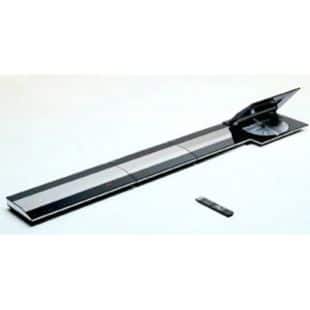
The simplicity of the exterior was matched by simplicity of operation. A light touch directly on the illuminated display gave immediate access to the system. Or, you could operate BeoSystem 4500 with the BeoLink 1000 terminal, summoning forth magical sounds from the comfort of your favourite chair.
The BeoMaster 4500 receiver received both FM and AM – and was your communication link to the other sound sources in the system. Its operation was simplicity itself with an illuminated menu presenting all the options available. 20 radio stations could be pre-set providing you with instant access together with automatic fine tuning.
The BeoCord 4500 cassette recorder housed exciting details and distinguished technology. Like Auto Reverse, so you did not need to turn over the tape. Automatic registration of the type of tape, and Bang & Olufsen’s patented HX-PRO recording system that provided optimal sound reproduction.
The sound reproduction achieved by Bang & Olufsen’s CD 4500 CD player was truly outstanding. It played both 12cm and 8cm compact discs and had an ingenious ‘step’ function which allowed you to go straight to a chose track selected from anywhere on the disc.
In building the BeoGram 4500 turntable, Bang & Olufsen applied all its classic principles to ensure reproduction as close to perfection as possible. The electronically-controlled tangential arm played each record exactly as it was recorded. And there were built-in systems that helped prevent vibrations reaching the cartridge or turntable. BeoGram 4500 employed a finer, ultra-light MMC2 cartridge that combined distinguished sound reproduction with maximum protection for your records.
Designed by Jacob Jensen, Beosystem 4500 in 1989 received the Japanese Good Design Award for its elegant design
If you crave maximum audio-visual performance for your hard-earned cash, there’s only one route to take: go for separates. Buying separate audio and AV components means you cherry-pick the very best in each category. What’s more, beefier (with individual power supplies), selected components plus better screening against interference inevitably deliver a higher standard of baseline performance.
Alright, they usually take up more space, but separates-based audio and AV systems are much more interference-resilient and offer vastly more potential for future expansion – an important advantage in the fast-changing world of hi-fi, video and home cinema. The only real downer is that you have to sift through hundreds of components in order to find the gems but if its sound and performance you’re after, there’s only one way to go!
| Title | Categories | View |
|---|
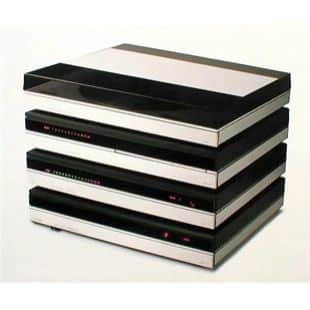
In the decade between 1970 and 1980 Japanese manufacturers were on the war path and the Bang & Olufsen board of directors was sweating. The popular trend was to stack components on top of each other in a rack, but the strategy adopted by Beosystem 5000’s designer – Jacob Jensen – was different altogether.
Jacob felt that the Japanese ideas were a mistake and spoke to B&O Board of Directors out loud, after which he jumped up and down on the stack of models he had designed. He looked at the group of 10-15 businessmen, now wide awake and expected a reaction but no one said anything except the economy executive Poul Skifter: “Well, we would like a note of credit for those models”.
The Japanese direction was abandoned. Later a compromise was made called Beosystem 5000, a B&O rack, which was named “The Best of Two Worlds”.
Beosystem 5000 was the first series of components from Bang and Olufsen in many years which returned to a ‘box’ design. The original units in the system were the Beomaster 5000, Beocord 5000, Beogram 5000 (Record Deck) – (and later in production the Beogram 5005 Record Deck), a two-way remote control unit unique to the 5000 system – the Master Control Panel 5000, a one-way hand-held remote control and a wide selection of Beolink® possibilities which could allow the 5000 to be operated from any room in a home, office or building. Beogram CD50 was later added to the System for playing compact discs.
Long, medium and FM wavebands were featured on this high-technology 2 x 55 watts receiver that served as the heart of Beosystem 5000 introduced in 1983 – the Beomaster 5000. A frequency synthesized tuner with automatic fine tuning and two-speed manual drive all contributed to fast, accurate location of radio programmes and superb reception quality. Nine station frequencies (on any combination of wavebands) could be stored in the Beomaster’s microcomputer memory for instant recall.
The low-distortion stereo amplifier included a very advanced feature, unique to Bang & Olufsen: Automatic Power Handling Control. This special circuit continuously monitored the dynamic range and power of the signal and instructed the microcomputer to decrease volume if the combined effects of these two parameters threatened to cause amplifier “clipping” or damage the speakers. This type of overload became increasingly common since the introduction of Compact Disc, which produces signals of enormous dynamic range, but it did not occur in the Beomaster 5000.
An internal, variable-speed fan ensured the proper dissipation of heat, even when the Beomaster is used in a stack format.
Beomaster 5000 had no visible controls. Normal operation was by means of the master Control Panel – a slim, table-top keypad that gave chair-side access to all functions including microcomputer programming and storage, timer facilities, status check, day and clock display, volume, tone and stereo balance adjustments and control of all sound sources. A programme-sequencing facility allowed you to pre-plan a whole evening’s listening composed of record, radio and cassette music in any order and combination. Once set, this “command performance” could play continuously as instructed without further use of the controls.
Direct operation of all primary functions was available on the Beomaster itself should the master Control Panel not be to hand. These controls were located beneath a hinged cover which sprang open at a touch. A separate, small Terminal – Terminal 5000 – was also available as an accessory to control Beomaster’s main functions.
The recommended speakers to complete Beosystem 5000 were Beovox S55. An ideal bookshelf speaker, Beovox S 55 could also be used as a wall-mounting speaker or free-standing model with the optional fittings available separately. The pressure cabinet contains an 22cm bass driver, an 11cm mid-range/phase-link unit and a 2,5cm tweeter. Power handling was 55 watts RMS.
If you crave maximum audio-visual performance for your hard-earned cash, there’s only one route to take: go for separates. Buying separate audio and AV components means you cherry-pick the very best in each category. What’s more, beefier (with individual power supplies), selected components plus better screening against interference inevitably deliver a higher standard of baseline performance.
Alright, they usually take up more space, but separates-based audio and AV systems are much more interference-resilient and offer vastly more potential for future expansion – an important advantage in the fast-changing world of hi-fi, video and home cinema. The only real downer is that you have to sift through hundreds of components in order to find the gems but if its sound and performance you’re after, there’s only one way to go!
| Title | Categories | View |
|---|
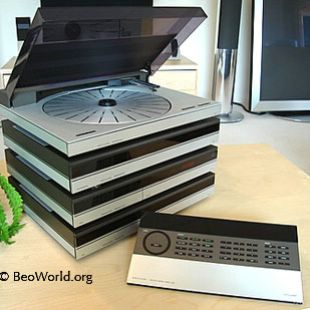
At first sight Beosystem 5500 looked almost too refined to be a musical powerhouse.
The clean, streamlined design, devoid of buttons and dials, gave no indication of the massive potential beneath. Looks are deceptive, however. Below those polished surfaces was a technologically-advanced record player, tape recorder, radio and compact disc player, plus an amplifier that could more than hold its own among the heavyweights.
Beosystem 5500 was technologically at its best – extremely powerful in design, wonderfully easy to use. The Master Control Panel gave you access to every function – and kept you informed as well.
Each time you gave the system an order, the light display would tell you what was going on. You could also programme ahead, just as easily. For example, if you want to be woken at a certain time in the morning with your favourite music or news, it was all there at your fingertips. The same applied if you wanted to tape a programme when you were out. Naturally, Beosystem 5500 was designed to form part of Bang & Olufsen’s round-the-house system, so it could also be operated through the Beolink 1000 remote control.
The modular design of Beosystem 5500 gave you complete flexibility in where you placed the different units. Stack them, range them side by side, or disperse them around the room. You could also acquire the system gradually – start perhaps with the radio/amplifier and tape recorder. Then treat yourself to the record player and CD player when you couldn’t wait any longer.
Beosystem 5500 was made up of the following individual units:
This was the brains of the system. Connected by Datalink to the record player, tape recorder and CD player it allowed you to remote-control the whole system via the Master Control Panel. The 2 x 60 watt/8 ohm tuner/amplifier gave you true hi-fi quality. Bang & Olufsen’s Automatic Power Handling Control system prevented overloading and distortion, regardless of how many speakers were connected. You could preset up to 20 stations on the tuner, and the frequency synthesizer would take care of automatic search and fine tuning of stations. The result – superb reception of LW, MW and FM wavebands, and impressive ease of use.
The quality of this CD player took time to fully appreciate. Take, for example, the elegant disc tray with its completely smooth and silent drive. Or the way that the disc drive system was mounted to isolate it from vibrations. Perhaps you were most impressed by the way that a built-in circuit in the player compensated for the tiniest faults on the disc itself (contrary to popular belief they’re not always perfect!) Finding tracks was fast and easy – just ask the Master Control Panel for the track number you wanted to hear. You could programme tracks to be played in any order, or sample each track briefly. There was a light display which shows you the length of the track you were playing, and the remaining time on the disc – invaluable for recording.
This advanced tape recorder was close to professional standard, bristling with features you would love to use., There was Auto Reverse, letting you play or record both sides of a cassette as one continuous tape. And automatic adjustment of sound levels avoided annoying volume changes from one recording to the next. Then there was B&O’s famous HX-Pro recording system which gave a vastly superior sound quality on the higher frequencies, creating a richer, more detailed sound image.
Beocord 5500 automatically adjusted itself to match standard, chrome or metal tapes. There was also the option of Dolby B or C during recording. During playback, the recorder automatically switched itself to the noise reduction system you needed. There was also of course, the refinement of automatic track search – just key in the track number and the recorder did the rest.
You couldn’t do better than Beogram 5500 to look after your valuable record collection. The electronically-controlled tangential arm played the record at the exact angle that the original master was cut. This allowed the ultra-sensitive MMC 4 pick-up to give the most precise possible reading of the signals in the groove. And with a stylus pressure of only 1,2g, this extraordinarily gentle touch added years to the life of your precious records.
Beogram 5500 was a tough customer though; dancing feet wouldn’t shake it up, courtesy of the special chassis suspension and short, rigid tone arm. There were also extra features such as the automatic registration of record size and speed; plus full track search and record repeat facilities, via the Master Control Panel.
However, if you treated yourself to B&O’s round-the-house TV, video and hi-fi system, you’d find the panel very useful.
For example, if you were in one of the linked rooms, you could look at the control panel to see what the music system in the main room was doing. Right down to checking details such as recording level.
Beosystem 5500 was Bang & Olufsen’s most advanced music systems up to the time of its introduction. With a minimum of operating procedures, you could enjoy musical experiences that were considered impossible a few years’ earlier. It controlled tapes cassettes, records, radio and compact discs and could be operated via Master Control Link.
The operating panel MCP 5500 gave you access to the whole of Beosystem 5500.
With this at hand, you could remote control all the units of the system and all of its functions. The infra-red two-way communications system ensured that you only had to look at the Master Control Panel to see what was happening and if your commands were being actioned upon. In other words, you were always in close contact with the system – no matter how far away it was… simple and logical.
All the elements in Beosystem 5500 were connected by Bang & Olufsen data link which meant in effect that each unit had a built-in microcomputer that controlled all functions. When they were connected they became a system that communicated collectively with the Master Control Panel.
In practise this meant that you could operate the system units from one location rather than operating each on its own. By enabling the units to communicate in this way, Bang & Olufsen devised very simple but effective operating procedure.
The Master Control Panel had buttons for controlling all the day-to-day functions of the record player, tape recorder, radio and compact disc player. And because each unit spoke the same language, each button controlled several functions. You could for example, use the FORWARD button to move the record player tone arm further inwards, go to the next track on a compact disc, fast-forward a tape cassette or move from one radio station to another. When you operated one unit in the system, you could operate them all!
Under the flap of MCP 5500 you found the operating panel for all the special functions like programming, which enabled you to order the system to wake you with music or record a concert even though you were not at home.
| Title | Categories | View |
|---|
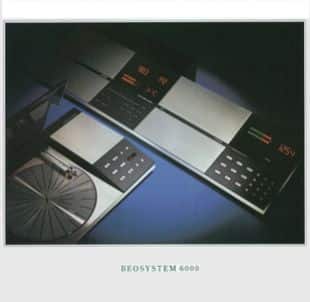
BeoSystem 6000 :
Alternatively to BeoCord 8004, there was the BeoCord 9000, which was similar to BeoCord 8004, but had Computer Controlled Calibration, which chose the best setting for each cassette.
Accessories:
| Title | Categories | View |
|---|